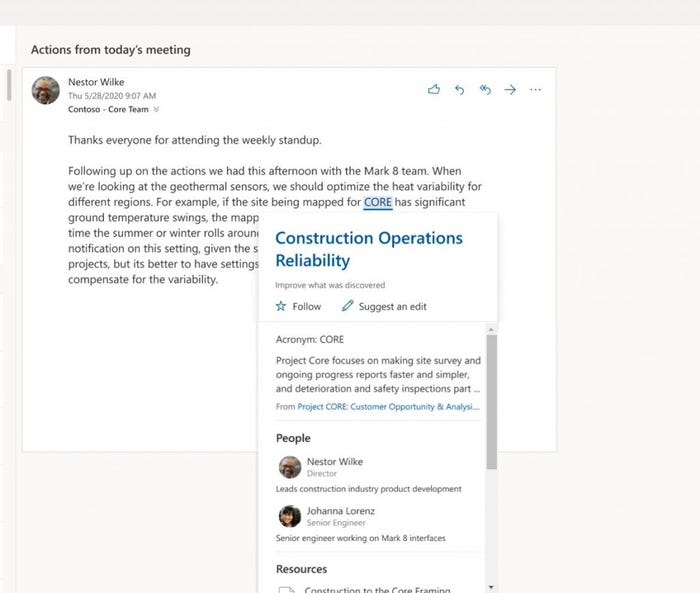Microsoft’s Project Cortex Knowledge Network Almost HereMicrosoft’s Project Cortex Knowledge Network Almost Here
New services using AI and knowledge APIs will enable modern enterprise search.
May 29, 2020

Microsoft’s Project Cortex, capabilities that aim to advance internal knowledge networks using artificial intelligence, will arrive early this summer.
The company announced the imminent release of Project Cortex during last week’s Microsoft Build conference, its annual gathering of developers. At Build, held online because of COVID-19, company officials demonstrated Cortex, introduced during last fall’s Microsoft Ignite conference. The company has offered the private preview to more than 75 customers.
Microsoft’s Project Cortex is not a specific product; rather, it is a collection of taxonomies and knowledge APIs that enable the surfacing of data and intelligence in Microsoft 365. It provides those services through the Microsoft Graph.
“Cortex showcases what’s possible with Microsoft Graph, the gateway to data and intelligence in Microsoft 365,” according to an update posted by Office GM Seth Patton.
Consisting of REST-based APIs and webhooks, the Microsoft Graph aims to provide a uniform programming model Microsoft 365 data. Besides the graph, Microsoft 365 as a platform includes Windows 10, Office and Enterprise Management + Security (EMS). The latter ensures Project Cortex solutions uniformly apply security policies and access control lists.
The Project Cortex APIs let developers embed search into content, exposed as topics when a user hovers over a term.

Microsoft’s Yina Arenas
“You can customize the way knowledge in your organization is surfaced and shared,” said Microsoft principal program manager Yina Arenas.
Arenas demonstrated the capabilities that customers and partners can create with Project Cortex during a keynote session at Build.
“Cortex then organizes that content and expertise across your teams and systems of record, interrelated topics such as projects, and then creates a knowledge network just for you and your organization,” she said.
In the demo, Arenas simulated a new employee at a company reading an email. By hovering over the word “core” in the message, it rendered a topic card image with a definition and context.

“All of this was automatically generated by mining the knowledge network behind Microsoft Graph,” Arenas explained. “In other words, Cortex generates knowledge tailored specifically and relevantly for you and your organization.”
Microsoft Graph Connectors
A key deliverable from Project Cortex are the Microsoft Graph connectors, which provide links to third-party apps and external data.

Microsoft’s James Lau
“The most critical one is probably search,” said Microsoft principal program manager James Lau, who leads the Cortex connectors team.
Lau said the graph connectors make data easily searchable through all endpoints accessible to the Microsoft Graph. Speaking during a Build technical session, Lau noted that Microsoft released a private preview of the connectors last fall.
Microsoft will extend the preview to partners and customers in the coming weeks, Lau said. Also, the company will add new connectors over the next few months, he said.
Lau noted that by importing external data, Project Cortex will use topic cards and topic pages to surface information.
“By building a graph connector and bringing in external data today, you can have search lit up immediately,” Lau said. “But the value of your connector will accrue more and more over time as more of these experiences light up in the future.”
Microsoft has created connectors that partners can link to …
… non-SharePoint-based intranets, on-premises file shares on-site instances of SQL Server. The company also has connectors to Azure Data Lake Storage Gen 2, MediaWiki and ServiceNow.
But there are also connectors to more than 100 other data sources from partners such as Accenture, BA Insight and Raytion.
BAinsight has connectors to Amazon S3, Box, Google Cloud SQL, and IBM’s Connections, DB2, Lotus Notes and WebSphere, among others.
New Managed Metadata Services
During Build, the company also revealed the forthcoming preview release of new Graph APIs for Microsoft’s Project Cortex. These new APIs will let developers work directly with Microsoft 365’s Managed Metadata Services.
The APIs are integrated as extensions to the Microsoft Graph, providing unified development throughout Microsoft 365, according to Patton.
“Managed Metadata Services provides a common taxonomy for tagging and classifying content across Microsoft 365,” he noted.
Naomi Moneypenny, director of product management for Project Cortex at Microsoft, co-presented with Lau during the Build session covering Cortex.
“It helps you to bring consistency and navigation and in search and in finding and discoverability inside of your organization,” Moneypenny said.
The new APIs will also enable managing of organizational metadata as part of Microsoft’s Term store, Moneypenny said. The Term store allows administrators to create and import terms into SharePoint Online and Microsoft 365 to implement taxonomies.
“We’ve done a huge amount of improvement, not just on the modern UI experiences, but also a whole new set of graph API’s that will be available at GA,” she added.
Partner Implementations
Massood Zarrabian, BA Insight’s CEO, believes Project Cortex will open new opportunities for partners to implement intelligent knowledge networks.
“I think it’s a huge opportunity for consulting houses and SIs to take advantage of Cortex with both information inside Microsoft and outside Microsoft to help customers find information faster, at lower costs,” Zarrabian said.
“The important part of this is that Cortex is mature. It will tag information in Office 365 and make it much more findable. It will use text analytics, AI and other things to make it so information that was hard to find, is now easier to find.”
Likewise, with connectors provided by partners such as BA Insights, they can extend beyond Office.
“It’s open enough so those of us who have connectivity to Office 365, can process information from other systems with Cortex of any entity,” he said. “The user will be able to find information 10 times faster with Cortex than without it.”
About the Author
You May Also Like


